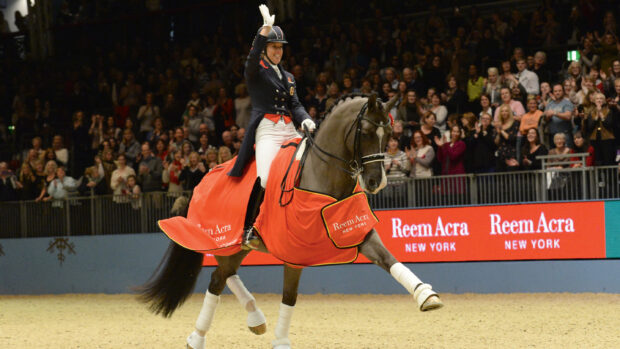Changes to FEI maternity rules in dressage and showjumping have been welcomed – but there remains no such provision for eventing.
Maternity leave in horse sport has been discussed at length over the years and extensively reported on by H&H. The topic was back under the spotlight when the FEI announced it would review the rules after Olympic champion Jessica von Bredow-Werndl was denied her planned competition return after having her second child, owing to the “FEI’s perception of the regulations” (news, 29 September).
This month, the FEI announced changes to the maternity rules for dressage, showjumping and driving to “introduce further flexibility” and give athletes the option of adapting the duration of their leave to their individual situations.
Under the new rules, the minimum maternity leave period has been reduced from six months to three; the maximum period of 12 months remains unchanged. Riders can come back earlier than originally indicated, by giving four weeks’ notice, or 10 weeks for showjumpers who wish to be eligible for CSI invitations. Riders will continue to retain 50% of their ranking points during this leave.
These rules have also now been introduced for endurance and para dressage, while vaulting is being examined by the technical committee.
World and European team gold medal-winning German showjumper Janne Friederike Meyer-Zimmerman, who was involved in founding campaign group EqualEquest following the birth of her son, said the changes are “positive” and the FEI is sending a “clear signal” to women in top class sport.
“Nevertheless, we will continue to be involved [in campaigning]. More self-determination and flexibility are essential so that women can remain competitive in equestrian sports,” she said.
The FEI said it had listened to the riders who wanted the option of returning to competition earlier than six months.
“The board is in favour of supporting athletes wishing to achieve the best balance between family and a high-level sports career,” said an FEI spokesman, who added that the FEI will “keep on reviewing” the maternity and medical leave across disciplines to make sure they remain “relevant and fair”.
But despite the latest review, eventing remains without any maternity rules. The FEI eventing committee said it considered including medical and maternity leave provisions, but it was “not in favour” owing to “risk management reasons”.
Five-star eventer Kirsty Chabert told H&H she believes event riders should be able to retain some of their points when they take time off to have a baby, and that returning to competition was in the “forefront“ of her mind after she had her son in December 2018.
“I don’t see why we shouldn’t be able to freeze our points, we’ve worked hard to gain them and we’re constantly trying to get back to the job as quickly as we can. I had a complicated C-section, but I still felt the need to be back competing as quickly as I could,” she said.
“Thinking of risk management, I would say eventing is the riskiest of the three disciplines, and possibly the most strenuous. When you’ve got to be able to hold your pelvic floor and core for potentially 11 minutes and jump down into drop fences and still be able to be safe, surely by freezing your points you’re then not rushing to get back doing a discipline that you might physically not be fit enough to do.
“I think there needs to be a generic rule that’s across the disciplines, if that’s possible.”
The FEI spokesman told H&H the safety of athletes is “paramount” and it was felt that freezing ranking points would be “counterproductive” in eventing.
“Maternity leave provisions were not proposed in eventing, reflecting the eventing committee’s position on safety. This follows extensive work with the community in the past years to reinforce the eventing risk management policy by implementing rules that put more emphasis on recent results, to ensure athletes and horses are active at the level they compete and, ultimately, to reduce risk,” said the spokesman.
“This includes rider categorisation, minimum eligibility requirements (MERs), return to play rules or development of the horse form index, among others. Trends are being monitored through the collection of data and statistics and these clearly show that using current results as part of the MERs is a strong contributing factor to safety.”
You might also be interested in:
‘I felt I was treated unfairly’: top riders call for changes to FEI maternity leave rules

Olympic champion ‘denied’ permission to return to competition in maternity leave dispute

Subscribe to Horse & Hound magazine today – and enjoy unlimited website access all year round
Horse & Hound magazine, out every Thursday, is packed with all the latest news and reports, as well as interviews, specials, nostalgia, vet and training advice. Find how you can enjoy the magazine delivered to your door every week, plus options to upgrade your subscription to access our online service that brings you breaking news and reports as well as other benefits.




